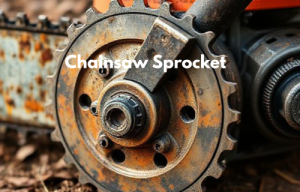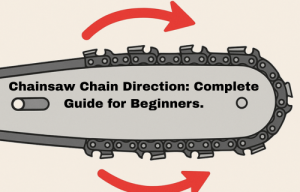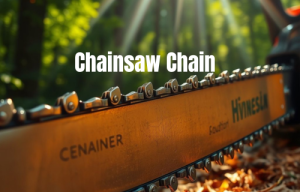What Do Chainsaw Chain Numbers Mean? A Simple Guide.
Introduction
Even the finest chainsaws can malfunction or turn hazardous with an improperly fitted chain. From a brand preference point of view, selecting the correct chainsaw cutting implements is not as simple as one might suspect it involves safety, effectiveness, and interoperability. That’s where chainsaw chain numbers come into play. These digits may seem random, but they contain vital clues regarding the design and compatibility of the chain.
Table of Contents
ToggleIn this article, you will learn everything necessary to confidently choose the correct Chainsaw Chain Type. Filling in knowledge gaps about the Parts of a Chainsaw and how they interact is essential if you want to get the most out of your tool even the best chainsaws depend on the right chain to function at peak performance.
Understanding the Basics: The Sharp Teeth in a Loop Form That Work Together
Decoding Your Chainsaw Chain’s Identity
Your sharp-toothed loops are more than that- they are sophisticated devices that assist in trimming trees sequentially. Three critical dimensions provide identity: pitch, gauge, and drive links, and these must correspond perfectly to your guide bar and sprocket while being inscribed on chainsaw chain numbers.
Pitch
It is expressed mathematically as the distance between three rivets divided by two. Adding length benefits how well equipped your chain will be with sprockets, thus overall usability of it also improves.
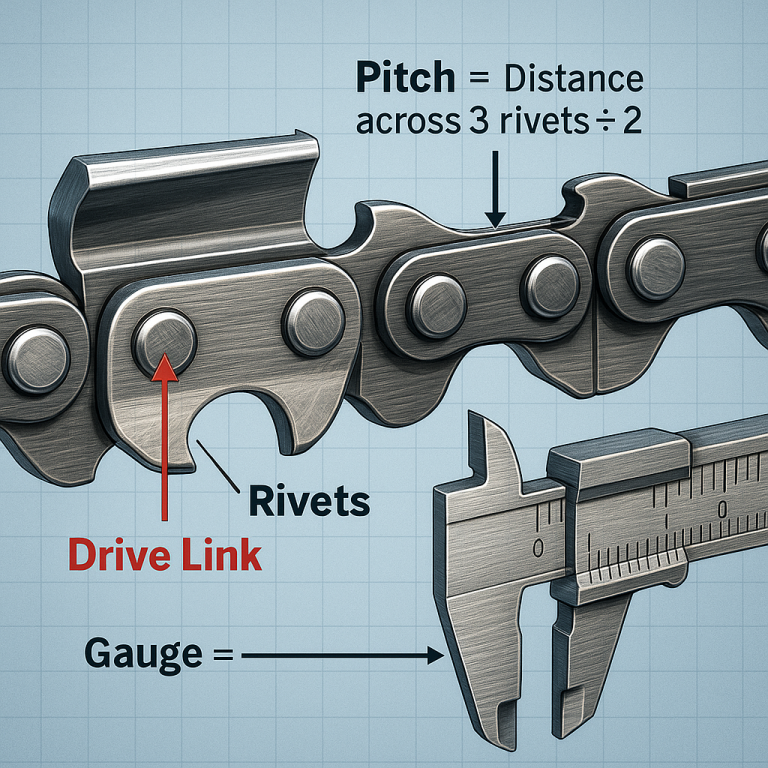
Common Pitch Sizes:
- 3/8″ Low Profile (LP)
- .325”
- 3/8”
- .404”
The wrong pitch will cause disengagement of the chain, with danger either slipping or snapping in the process.
Gauge
Gauge is the width of the guide bar’s groove and shape, which is shaped into the chain’s drive links.
Common Gauge Sizes:
- .043”
- .050”
- .058”
- .063”
If your gauge does not match too shallow, curb leads to excessive wobble, leading to binding, risking an obvious safety hazard.
Drive Links
Tooth-like tabs referred to as drive links fit inside a sprocket as well, and the number of sprockets required determines the length of the chain.
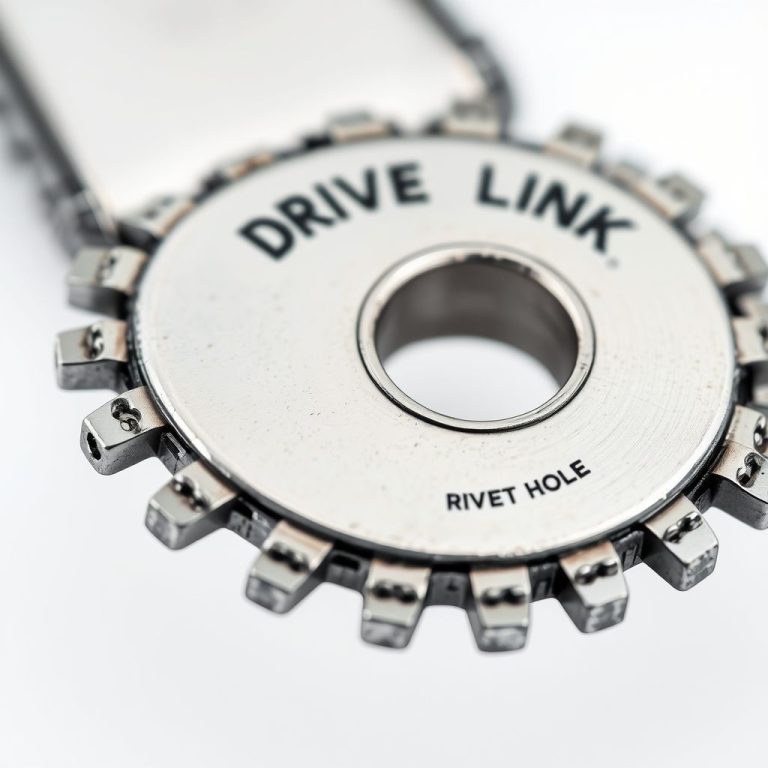
You must document every single spanner when replacing your patch rods; otherwise, this results in dangerous attempts around operating tools, finally.
Every chainsaw depends upon accuracy alongside replacement part growth amid precision growth; therefore, every performance hinges squarely on all pier relationships measurements via pitch, spans, among segments, drivers, joint securely tool tool-free run, devoid of risk.
Beyond The Figures – How To Pick A Chainsaw Chain Type
Selecting Your Chain For a Particular Task
Chainsaw Chain Type requires careful consideration. Like every other tool in the workshop, chains are designed differently for specific materials, levels of experience, and purposes. If your using Husqvarna chainsaw refer to this guide for selecting chain Husqvarna chainsaw chain
Basic Cutter Designs
- Full Chisel: Fastest and most aggressive cutting with clean wood. Becomes dull fast in frozen or dirty wood.
- Semi-Chisel: Slower than Full Chisel but stands up to sharpness longer to dirt and hardwoods.
- Low Profile (Chipper): Easiest to handle; low kickback power makes this ideal for beginners/small saw users.
Chain Arrangements
- Full House: Every drive link has a cutter produces smooth, clean cuts.
- Semi-Skip: Slightly fewer cutters offers a balance between speed and smoothness.
- Full-Skip: Fewer cutters ideal for long bars and rough cutting.
Specialized Chains
Adding specialty carbide tips allows chains to tackle freezing temperatures or abrasive surfaces through increased durability at the cost of special sharpening for angles that hand tools cannot do.
The efficiency of working includes saving time while executing the task, which in turn means having the appropriate chainsaw chain type. Proper selection helps maintain durability not only on the Chainsaw Chain but on the Quality of Chainsaws too.
🎥Understand chainsaw chain
Practical Steps: How to Find Specifications for Your Chain
Where to Find Numbers Relating to Your Chainsaw. If you are not confident regarding a particular chain’s specifications, multiple avenues can be explored.
Steps to find chainsaw chain numbers
- Check the Guide Bar: Most manufacturers stamp pitch and gauge information here.
- Inspect the Drive Links: Some chains have numbers etched into the links.
- Consult the Owner’s Manual: This is the most accurate source of compatibility data.
- Measure Manually:
- Gauge: Use a caliper or a specialized gauge tool.
- Drive Links: Count each drive link that fits in the guide bar groove.
Accuracy is important. A small mismatch could cause damage due to excessive wear and tear or result in having a chain that doesn’t fit, rendering even top-tier chainsaws useless.
Maintenance and Safety: Keeping Everything Balanced
Routine maintenance requires constant attention, ensuring your tools are sharp, with adequate cleanliness, and proper lubrication levels. Dull blades cause heavier strain on parts like the sprocket and guide bar. In addition, confirm that your chain brake, oiling system, and tensioning mechanism are in good working order. These parts work very closely with your chain and need to be synchronized for best performance.
Neglecting the Parts of a Chainsaw can lead to premature failure, even if you’re using a premium Chainsaw Chain Type.
Conclusion
Understanding chainsaw chain numbers is more than just a technical detail it’s foundational knowledge. By learning how pitch, gauge, and drive links work, you empower yourself to choose the right Chainsaw Chain Type for your needs. This leads to better performance, improved safety, and longer-lasting equipment. Always remember: even the best chainsaws can only do their job well if paired with the correct chain.
✅ Stay Safe, Cut Smart.
📌FAQs
Pitch, gauge, and number of drive links. These determine if a chain will fit your saw.
Use a ruler and caliper, or a chain gauge tool. Measure across three rivets for pitch, and measure the thickness of a drive link for gauge.
Because components like the bar and sprocket must align precisely with the chain dimensions for safe operation.
Reduced cutting speed, excessive vibration, or smoke while cutting. These indicate dull or worn-out chains.
Not exactly. While the numbers may match, always verify compatibility with your saw’s manual or manufacturer’s guide.
Related Post
Chainsaw Sprocket Maintenance: A Beginner’s Guide.
Chainsaw Sprocket Maintenance: A Beginner’s Guide....
Read MoreBest Practices for Storing Chainsaws in a Shed or Garage.
Best Practices for Storing Chainsaws in...
Read MoreWhat Is Chainsaw Idle Adjustment and How to Achieve It?
What Is Chainsaw Idle Adjustment and...
Read MoreChainsaw Chain Direction: Complete Guide for Beginners.
Chainsaw Chain Direction: Complete Guide for...
Read MoreWhy is my Chainsaw Chain not moving?
Why is my Chainsaw Chain not...
Read MoreWhy Does My Chainsaw Bog Down When Accelerating?
Why Does My Chainsaw Bog Down...
Read More